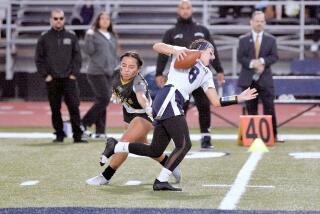FOCUS : Where Old and New Coexist
- Share via
Central Westminster’s got the real McCoy: The oldest building of early city history still intact is named, appropriately enough, the McCoy-Hare House. This modest structure was the city’s first drugstore, built in 1874 by the city’s first physician, Dr. James McCoy.
McCoy came to Westminster in 1873 at the invitation of the Rev. Lemuel P. Webber, who founded Westminster Colony in 1870. The pharmacy was operated by the doctor’s sister, Martha (Mattie) McCoy, who continued working as the druggist for years after her brother moved to Beaumont.
Through the years, the building was expanded to serve as a home and in 1912 was purchased by Orel C. Hare and his bride, Marie Larter Hare. Marie Hare became a local educator of some renown. The school where she taught and was principal for 26 years was named after her.
Upon her death, she donated the house, which stood on Westminster Boulevard, to the city to ensure its preservation. The city had its eye on the house at the same time--for demolition, with the intention of extending Olive Street northward through the Hare property.
The house, built of redwood in the board-and-batten fashion and put together with square nails, was moved to Heritage Park, next to the Chamber of Commerce on Hazard Avenue at Beach Boulevard, in conjunction with the city’s part in the national bicentennial celebration in 1976.
The park boasts a variety of trees--fig, fir, avocado, eucalyptus, pepper--including the so-called Freedom Tree planted by the National League of Families of Americans Missing in Southeast Asia in 1973 to commemorate those missing in action in the Vietnam War. The Kiwanis Club built the flagpole rising in the field. The Camp Fire Girls built the brick well. The house has been restored to its original form--that is, with the little pharmacy in one room and living quarters behind. On the shelves, bottles that once held medications are sealed with corks, as was the practice in the late 19th Century. A book full of prescriptions dating as far back as 1890 lies on the counter. Another volume has recipes for prescriptions, instructions on how to mix ingredients for the healing potions.
The second room has been recast as a sitting room such as Mattie McCoy might have had beside her pharmacy. A hand-operated phonograph still works and plays a single song. A sewing machine sits by the window.
Such remnants of the past are few in Orange County today, yet this neighborhood has two. The second, the Westminster Auditorium, at 7571 Westminster Blvd., was a Works Projects Administration effort (one of the few remaining in the county) completed in 1940 to replace a school damaged in the 1933 earthquake. A private developer, the Delma Corp., intending to build a 312-unit housing project for senior citizens on the former school site behind the auditorium in 1986, originally planned to raze the auditorium. But the City Council voted to keep the building.
Now called the Westminster Cultural Arts Center, the two-story, beige stucco structure, which seats 625 and features a meeting room, is rented out for dance classes and Boy Scout functions and accommodates plays, meetings, movies, concerts and ceremonies. The neighborhood has acquired a mixed architectural complexion beyond those two historical sites. Its residential offerings are a mix of apartments, mobile homes and single-family houses.
The Westminster Senior Apartments complex today wraps around the auditorium along Hoover Street and California Avenue.
Two mobile home parks are also on Hoover Street: At 21st Street, the Caravan Trailer Lodge shows trees rising over the retaining walls enclosing the area; another, the Westminster Mobile Estates, stands north of Suzi Lane.
Modest single-family homes with front yards and lawns and flowers only occasionally have fences around them. One single-family home on Arizona Street at the corner of California Avenue suggests an enterprising inhabitant. A sign reads “Dorothy’s Dolls and Stuffed Animals, Handmade Gifts,” and the table set up in front of the garage offers two-foot-tall windmills, a wooden rocking horse and stuffed Easter bunnies. Next door, a row of cedar saplings is breaking ground.
The neighborhood, once almost exclusively white and Latino, does not now seem that way to the casual visitor. Children playing in front yards, walking home from school or sitting in the shade to avoid the midday heat are mostly Southeast Asian. At least two cafes on Westminster Boulevard are Vietnamese. A local bakery is called Me Samoan.
All seem signs of change in a neighborhood whose major icons celebrate preservation.
Population Total: (1989 est.) 2,650 1980-89 change: +3.0% Median Age: 27.9
White (non-Latino): 64% Latino: 28% Black: 1% Other: 7%
By sex and age: MALES Median age: 27.1 years FEMALES Median age: 28.7 years
Income Per capita: $9,793 Median household: $23,937 Average household: $20,417
Income Distribution: Less than $25,000: 62% $25,000-49,999: 29% $50,000-74,999: 8% $75,000-$99,999: 1%






